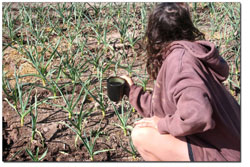|
| ||
| The slow boat school of shopping
by Ari LeVaux
In the above meals, local staples are combined with what I call “slow boat” ingredients – low-maintenance foods that can be transported slowly, unrefrigerated, without burning much carbon. The fact that curry powder, black peppercorns, powdered chocolate, or a can of oyster sauce were shipped from afar doesn’t diminish the localness, and awesomeness, of the meal. Many locavore-types get hung up on this issue, clinging to the letter of eating local while forgetting about the spirit of it. In spirit, eating local reduces transport-related carbon emissions, supports your local economy and helps you become native to a place. As you learn the traditions, landscape and seasonal rhythms of your home ground, you’ll see the plum blossoms in spring and think about the chutney you’ll make in fall. And the fact that your chutney contains ginger won’t diminish its localness. You’ll look forward to strawberry harvest in summer and pray for a good rain after you’ve picked your fill. And it won’t rain on your breakfast parade when you eat that jam spread on local bread while drinking a cup of Ethiopian coffee. If the eggs in that breakfast are from the back yard, and the bacon is from a local farm, and the salsa is homemade, then the meal is local in spirit, despite the coffee in your cup, the black pepper on the eggs, or the fact that the tomato in your salsa originated, centuries ago, from a Central American progenitor. Countless culinary developments of great import have resulted from imported food. Italian pasta would not have been invented were it not for Chinese noodles; South American peppers and potatoes have gone global; and mayonnaise, of course, came all the way from heaven. There’s nothing inherently wrong with shipping exotic ingredients from the other side of the world. How something is transported is usually much more significant than how far. Shipping something 100 miles by truck can burn more fuel than shipping something 1,000 miles by train, or 100,000 miles by sailboat. Indeed, shipping by sailboat is as close to carbon-neutral as it gets. That’s why sailboats are the namesake of the slow boat school of shopping. Slow boat shopping is based on the fact that when Marco Polo brought back noodles and spices from China, he did so in his carbon-neutral sailboat, which wasn’t equipped with a refrigerator. Thus, he was limited to foods that wouldn’t spoil. To determine if a certain food import qualifies as slow boat, I ask myself two simple questions: Could this food have been produced at home? Could it have been shipped slowly and not refrigerated? If the food can be produced close to home, then I make every effort to get as much of it as necessary in-season, and preserve it appropriately so I can eat it year round. But if the food is exotic to my area – such as coconut or avocado – I focus on the method of transport rather than mileage when deciding if I should buy it. Today, beyond a few shipments of boutique wines that cross the pond each year by sailboat, very little food is transported by wind power. And even if more food were blown here on a slow boat, the method of transport isn’t usually on the label, so it would be impossible to know it. But if you stick to food imports that aren’t refrigerated, then at least you are creating a diet based on foods that could have been shipped by slow boat –or the terrestrial equivalent: the unrefrigerated train car. The items that are shipped from afar should be used to enhance a local diet, not replace it. Adding coconut milk to a pot of New Mexico red chile, for example, creates a delicious variation on a proud regional dish. One of my favorite such variations is New Mexico Red Curry. To make this dish, start by removing the seeds from eight dried New Mexico or Anaheim red chile pods, and soak the pods in hot chicken or veggie stock. Meanwhile, peel one head of garlic (five to eight good-sized cloves). Add the garlic cloves, a teaspoon of salt, and a tablespoon of dried oregano to a blender, with enough stock from the soaking chiles to blend. Then add the soaked chile pods to the blender, along with more soaking liquid to make what looks like red paint. Steam some potatoes, cut into chunks and fry in a pan until crispy on all sides. Add a chopped onion to the pan and sauté until translucent. Then add the chile sauce. Cook on medium heat, tasting frequently, for about 10 minutes – until the flavor of the garlic in the chile mellows. Then add a can of coconut milk, and cook for another 2 minutes. Serve with rice and steamed vegetables – ideally veggies you blanched and froze last summer. You could also add the veggies earlier and let them cook in the curry. It’s a meal that thinks globally, acts locally and tastes great. •
|



 Locavore fundamentalists might call it blasphemy, but there’s no reason why a meal made with local foods can’t also contain ingredients from the other side of the world. Homegrown vegetables like broccoli and garlic stir-fried with oyster sauce; locally raised lamb curry with homegrown potatoes; deer steak with salt and pepper; chocolate beet cake.
Locavore fundamentalists might call it blasphemy, but there’s no reason why a meal made with local foods can’t also contain ingredients from the other side of the world. Homegrown vegetables like broccoli and garlic stir-fried with oyster sauce; locally raised lamb curry with homegrown potatoes; deer steak with salt and pepper; chocolate beet cake.